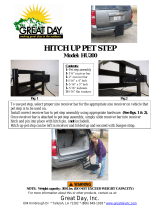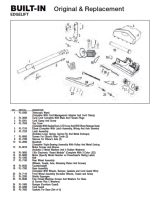
5
CroozerDog18-ENG-5-18
Safety Guidelines
Safety Guidelines
Symbols and warnings
DANGER indicates a hazardous situation which, if not
avoided, will result in death or serious injury.
WARNING indicates a hazardous situation which, if not
avoided, could result in death or serious injury.
CAUTION indicates a hazardous situation which, if not
avoided, could result in minor or moderate injury.
NOTICE indicates a situation which, if not avoided, could
result in damage to the Croozer Dog or the environment.
Tip: In this manual, “Tip” indicates helpful advice about
the use or maintenance of the Croozer Dog.
Read and observe this manual!
This manual contains information that is extremely impor-
tant for the safety of you, your dog and other road users.
Therefore, it is essential that you read the entire manual
carefully and follow the instructions closely. If you should
experience difculties understanding any of the informa-
tion or instructions, please contact your Croozer dealer.
Keep this manual handy at all times for future reference.
If you loan or sell your Croozer Dog, pass on this manual
to the new user. It is also vitally important that you read
and observe the instructions provided in the manual of the
towing bicycle.
Who can ride the towing bicycle?
Be sure to acquaint yourself with the applicable laws in the
state or country where you plan to use the Croozer Dog.
Requirements for the towing bicycle
The towing bicycle must be approved by its manufacturer
for pulling a trailer. This information can be found in the
owner’s manual of the bicycle. Furthermore, the towing
bicycle must be in perfect working order and have strong,
properly functioning brakes. The rear wheel of the towing
bicycle must be equipped with an effective mudguard with
mud ap. Otherwise, your dog could be injured by stones
and other debris thrown up from the road. Motorised
vehicles may not be used for pulling Bicycle Trailers. The
only exception to this rule is a pedelec. This special type
of e-bicycle has an electric motor that delivers assist only
when the rider pedals. In many countries, pedelecs legally
qualify as bicycles. However, e-bikes with a maximum
speed of more than 15 mph (25 km/h) may not be used for
pulling the trailer. The towing bicycle should be equipped
with a sturdy rear-mount kickstand to ensure safety when
loading and unloading your dog.
Be sure to familiarise yourself with the legal requirements
that apply to towing bicycles in the country or state where
you will be using the Croozer Dog.
The towing bicycle must have a 26” to 29” (559 to 635 mm)
rear wheel. This information can be found on the tyre
sidewalls. The numbers 42-622, for example, indicate that
the tyre has a width of 42 mm and a bead-seat diameter of
622 mm (28 inches).
Legal requirements for using a Bicycle
Trailer
Be sure to familiarise yourself with the legal requirements
that apply to pulling a bicycle trailer in the country or state
where you will be using the Croozer Dog.
Before your rst ride ...
It is important that you familiarise yourself with the Croozer
Dog before you use it for transporting your dog. Prior to
your rst trip, we recommend taking a practice ride (with-
out your dog) in a calm, trafc-free area; load the Bicycle
Trailer with cargo of approximately the same weight as
your dog, for example, by strapping a loaded rucksack into
the cabin. This is a great way to acquaint yourself with the
handling of the bicycle and the dimensions of the trailer.
You will also need to help your dog get used to the Croozer
Dog (see page 19).
Crushing hazard
When folding and unfolding the Croozer Dog, keep ngers
and hands clear of all possible pinch points (e.g. movable
frame parts and locking mechanisms).
Pulling the Croozer Dog as a Bicycle Trailer
Before each ride, check the following:
• Are the side wheels securely attached?
• Are the two locking mechanisms properly engaged
(pins locked into the holes)?
• Is the hitch arm properly attached and secured? Is
the trailer properly hitched to the towing bicycle and
secured with the safety strap? Are all Click & Crooz
®
fastening systems and security pins (e.g. ball lock pins)
correctly inserted and secured? Make sure there are no
security pins hanging freely from their straps.
• Are the tyres inated to the correct pressure? The
actual tyre pressure should never be higher or lower
than the maximum and minimum ination pressures
marked on the tyre sidewall. (See also page 29). Never
use compressed air, e.g. from a gas/petrol station, to
ll your tyres. The rapid airow and high pressure can
over-inate the tyres, causing the tube and/or tyre to
burst.
Turning
Always reduce your speed to a walking pace when mak-
ing turns with the Bicycle Trailer. Keep in mind that riding
speed is often underestimated, especially on bikes with
electric assist. When turning at high speeds, the increased
centrifugal force can cause the Bicycle Trailer to skid or tip
over and result in accidents with serious injury or death.
Riding downhill
Always reduce your speed when riding downhill. Riding at
excessive speeds can cause the Trailer to skid, potentially
resulting in accidents with serious injury or death.


































